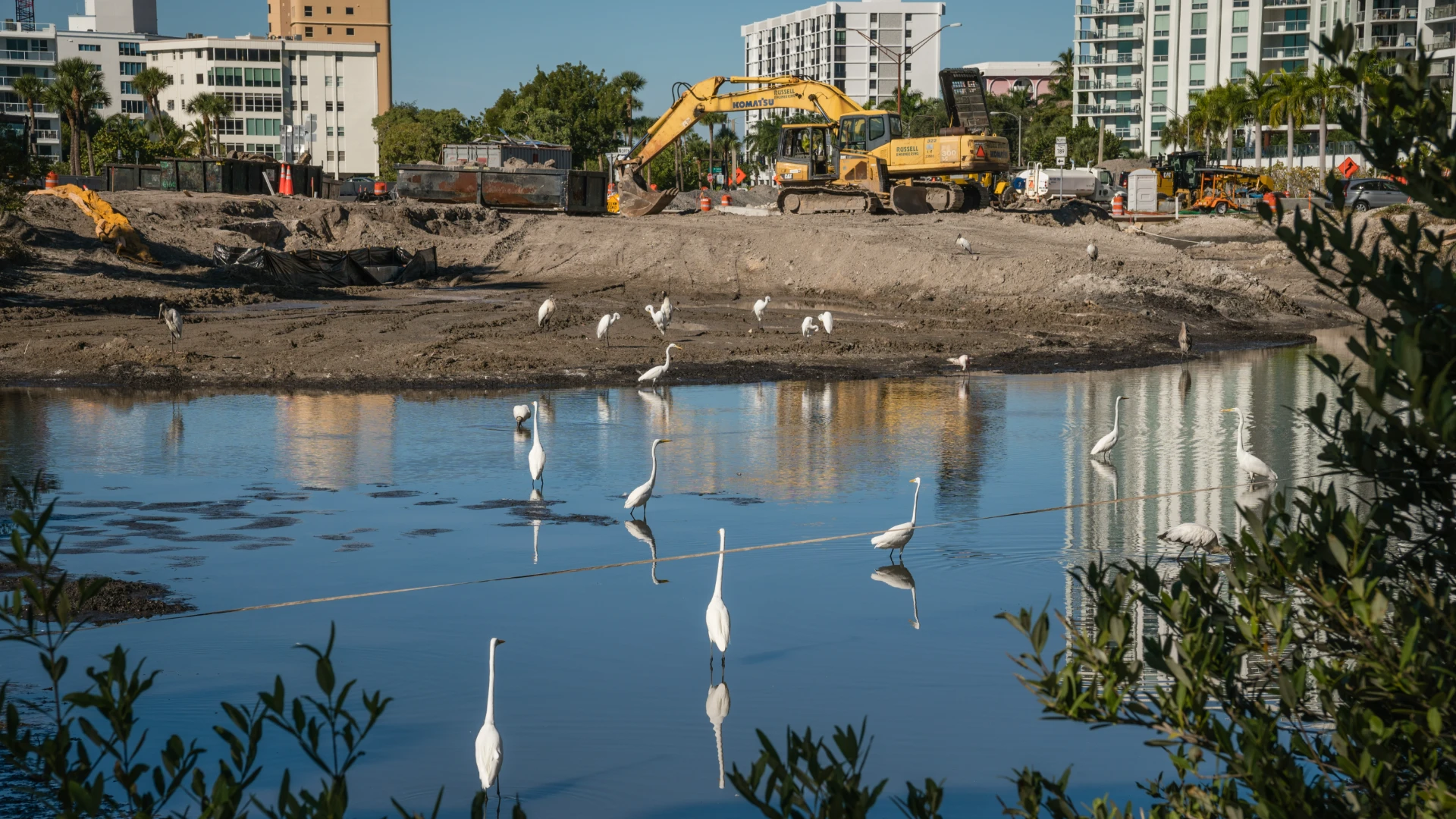Land pollution severely affects the health of our planet and its inhabitants. As stewards of the Earth, we are responsible for minimizing and rectifying the damage caused by land pollution. Historically, many practices contributing to this problem were conducted out of ignorance or lack of regulations. Today, we recognize the urgency to clean up after those who came before us, implementing strategies and technologies to remediate polluted property to its natural state. Our duty extends beyond prevention to remediation, ensuring a healthier environment for future generations.
What is Land Pollution?
Land pollution is the degradation of the Earth’s surface caused by improper disposal or accidental release of harmful substances into the ground, water, and air. It can take various forms, including:
- Industrial Waste
- Urban Waste
- Agricultural Waste
- Mining Activities.
- Chemical and Nuclear Pollutants
- Deforestation
- Oil Spills
- Construction Waste
- Landfills
- Electronic Waste (E-waste)
- Sewage Sludge
- Plastic Pollution
- Textile and Leather Industries
- Medical Waste
- Atmospheric Deposition
- Accidental Spills and Leaks
- Battery Disposal
- Radioactive Waste
- Invasive Species
- Vehicle Pollution
- Military Activities
- Uncontrolled Hazardous Waste Sites
- Non-point Source Pollution

Examples of How Land Pollution Occurs and How It’s Resolved
While land pollution occurs in countless ways, both naturally and due to human interference, we face several recurring types of pollution when working with clients who are in need environmental remediation. Our primary objective is to trace the pollution back to its source and access historical insurance policies that were active at that time. In doing so, we can help our clients mitigate environmental cleanup costs while restoring polluted land to a healthier state. The following is a select list of examples of land pollution that our company has confronted over the past decades.
Auto Body Shop Land Pollution
Since their inception, auto body shops have been associated with pollution affecting soil and groundwater. These shops have structural features, including oil pits, hydraulic hoists, painting booths, and cleaning facilities that use different chemical solvents that pose the potential to transfer hazardous chemicals into the soil and groundwater. Historically, the government imposed minimal regulation on these chemicals, which led to much of the land pollution that current auto body shop and property owners are now responsible for cleaning.
Brownfield Land Pollution
Brownfields are former industrial or commercial hubs, often riddled with pollutants like heavy metals, hydrocarbons, and chemical residues. These contaminants primarily stem from historical industrial activities, antiquated waste disposal methods, and leakage from old storage tanks. Until the environmental contamination is addressed, attempts to expand, redevelop, or reuse the land will continually encounter complications due to its presence.
Bulk Plant Facility Land Pollution
Bulk plant facilities have been pivotal in fuel storage and distribution throughout our nation’s history. Still, historically insufficient containment practices, general infrastructure limitations and fuel spills occurring while filling tanker trucks, rail cars, and equipment during operations. This led to soil and groundwater contamination, turning these sites into environmental hazard hotspots.
Bus Barn Land Pollution
Bus Barns are integral to fleet vehicle maintenance throughout the transportation industry, and land pollution issues have plagued them since the beginning of operation. Hydrocarbon spills from fueling operations and contamination from chlorinated cleaning solutions often challenge these sites.
Car Dealership Land Pollution
Older car dealerships are often battlegrounds against land pollution, grappling with issues stemming from antiquated Underground Storage Tanks (USTs), fueling facilities, and car washes that did not have measures to retain, treat, or recycle dirty water. This historically low standard of care led to soil and groundwater contamination that isn’t generally discovered until the property’s redevelopment, sale, or refinancing.
Dry Cleaner Land Pollution
Dry cleaning establishments have a longstanding history of using persistent chlorinated solvents like PCE, or PERC, that cause significant soil, groundwater and vapor intrustion pollution. To make matters worse, the density of these chemicals causes them to sink into the water column, allowing them to travel substantial distances. This makes PCE remediation one of the more costly, time-consuming, and daunting remediation activities.
Farming & Agriculture Land Pollution
Farming and agriculture have served as the backbone of our country and have kept us all fed and happy for centuries. However, decades of productivity-boosting practices, like using pesticides, fertilizers, and fueling stations, have led to significant soil and water contamination.
Gas Station Land Pollution
Like bulk plant facilities and bus barns, historic gas stations caused a lot of land pollution due to fuel spills and poorly designed infrastructure, including Underground Storage Tanks. While years of increased regulation have improved these issues, many properties that were once gas stations have been converted into new businesses, such as coffee shops, fast food restaurants, and used car lots. Old land pollution and other environmental liabilities often come to light when these conversions happen and must be addressed.
Industrial & Manufacturing Land Pollution
Industrial and manufacturing sites are commonly afflicted with land pollution, characterized by the presence of hazardous chemicals, heavy metals, and other manufacturing byproducts that contaminate the surrounding environment.
Landfill Land Pollution
Old landfill properties are redeveloped and integrated into urban areas as cities expand. However, many old landfills were not properly sealed or capped, posing significant risks of contaminant seepage into the surrounding soil and groundwater. Before these sites can be integrated, the major environmental concerns they face must be addressed to ensure they are safe for the general population.
Redevelopment Land Pollution
As redevelopment expands throughout every major city across the country, the ‘clean’ sites available for improvement are diminishing, leaving only more challenging sites, like those with notable pollution, available for redevelopment. Many of these sites were used for industrial or commercial purposes, requiring significant environmental cleanup before development could proceed.
Residential Land Pollution
Historically, many residential properties and homes stored fuel in Underground Storage Tanks (USTs) used for heating. Like with gas stations, these storage tanks can be sources of land pollution, affecting both the soil on the property and neighboring areas.
Waterfront & Maritime Land Pollution
Waterfront and maritime properties, encompassing everything from waterfront homes to deep-water ports, frequently feature creosote piles and heavy timber bulkheads, which can leach harmful chemicals into water and sediments over time.

A Look at the Environmental Remediation and Land Pollution Cleanup Process
Regardless of the history of a polluted site, environmental remediation and pollution cleanup involve a similar multifaceted approach that considers the immediate need to address existing contamination and the long-term strategies to prevent re-contamination as well as future incidents. The process involves technical remediation activities and administrative and operational changes to ensure ongoing compliance with environmental standards and to safeguard public health and the environment. While each form of pollution requires a nuanced approach, let’s take a look at the general process that takes place.
1. Initial Site Assessment and Investigation
The remediation begins with engaging and Environmental Consultant to look at the history of the site to better understand the facility’s operational history. Then, an Environmental Site Assessment (ESA) may be necessary to identify potential and existing contamination through soil, water, and air sampling.
2. Risk Assessment
The next step is to assess each identified contaminant’s risks to human health and the environment. This assessment helps determine the urgency and extent of remediation needed.
3. Remediation Planning
Once the site history, ESA, and risk assessment are complete, a comprehensive remediation plan is developed to address identified contaminants. This plan often requires approval from environmental regulatory agencies and may involve community engagement, especially if the site is near residential areas or sensitive environments.
4. Cleanup and Remediation
Once the remediation plan is approved, soil, groundwater, and vapor intrusion cleanup can begin.
- Soil remediation includes excavation and removal, bioremediation (using microorganisms to break down hydrocarbons), and in-situ chemical oxidation for treating more complex contaminants like chlorinated solvents.
- Groundwater treatment includes pump-and-treat systems, air sparging (injecting air to volatilize contaminants), or in-situ chemical treatment.
- Vapor intrusion mitigation involves implementing measures to prevent the migration of volatile contaminants into indoor air, if necessary.
5. Infrastructure Improvements
If the facility plans to continue operating, infrastructure improvements must be made to ensure re-contamination doesn’t occur.
6. Ongoing Monitoring and Maintenance
The site may need to continuously monitor groundwater post-remediation to ensure the effectiveness of the cleanup efforts and to detect potential re-contamination. Also, regular inspection and maintenance of systems may be needed to prevent future pollution.
7. Regulatory Compliance and Reporting
Finally, the site must receive regulatory closure or compliance to indicate that it meets environmental safety standards. This happens by continuously documenting and reporting all remediation activities, monitoring data, and maintenance actions to regulatory agencies and stakeholders.
We must Minimize Land Pollution and Clean Up After Those Who Came Before Us
As we confront the legacy of land pollution, we must remember our responsibility towards the environment. The task of cleaning up after previous generations, who may not have been aware of the environmental impacts of their actions, falls upon us. We can effectively address these challenges through comprehensive environmental remediation, innovative technologies, and a commitment to sustainable practices.
Our role extends beyond fixing past mistakes; it’s about creating a cleaner, safer world for future generations. As professional insurance archaeologists at Restorical Research, we are committed to uncovering historical policies to fund these vital cleanup efforts, bridging the gap between past practices and a more environmentally responsible future.




